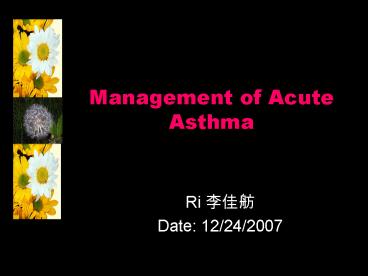Management of Acute Asthma - PowerPoint PPT Presentation
1 / 17
Title: Management of Acute Asthma
1
Management of Acute Asthma
- Ri ???
- Date 12/24/2007
2
Asthma
- Chronic Inflammatory disorder of bronchi
characterized by Episodic, reversible
bronchospasm resulting from an exaggerated
bronchoconstrictor response (hyperreactivity) to
various stimuli (allergy) - Hyperreactivity ? obstruction of airways,
severity widely variable in the same individual - Affects 10 of children 5-7 adults
3
Asthma? airway obstruction, hyperinflation, and
airflow limitation Airway remodeling
Subepithelial fibrosis, Sm m. hypertrophy,
submucosal gl hypertrophy, airway wall thickening
4
Emergency Department Management
- History-- Recent ER visit, current oral
corticosteroid use ? AE-- Previous resp.
failure, progressive worsening of symptoms,
seizures with asthma attacks ? severe,
potentially fatal asthma
5
Emergency Department Management
- PE-- Resp. distress at rest, difficulty in
speaking in sentences, diaphoresis, agitation--
RRgt28, HRgt110, pulse paradoxusgt25 mmHg-- Use of
accessory muscles ? severe airflow obstruction--
Presence of SCM / suprasternal retractions ?
impairment in lung function
6
Asthma Attack Evolution
CHEST / 125 / 3 / MARCH, 2004
7
Thorax 200762447-458
8
(No Transcript)
9
Thorax 200762447-458
10
Thorax 200762447-458
11
ICU Management
- Pt simply require additional time for resp.
function to improve - In the past, mainstay of Rx for pt progressing
to resp. failure from asthma was intubation and
mechanical ventilation - Alternatives to intubation
- NIPPV (Noninvasive Positive Pressure Ventilation)
- Inhaled general anesthetics
- Continuation of pharmacotherapy
CHEST / 125 / 3 / MARCH, 2004
12
NIPPV
- Potentially beneficial effects result from
- Reduction in the increased work of breathing
- Decrease in inspiratory threshold load
- Demonstrated significant reductions in PaCO2
early in pt with AA - Improved lung function and decreased
hospitalization rate
CHEST / 125 / 3 / MARCH, 2004
13
NIPPV
- Successful use first identified pt as high
risk, pt education, coordination with breathing
circuit - If with only marginal improvement, removal may
precipitate rapid deterioration - Initial ventilator setting
- PEEP 5 cmH2O
- Pressure support 8 cmH2O
CHEST / 125 / 3 / MARCH, 2004
14
NIPPV
- With largest possible ETT
- Mechanical ventilation follows cardiorespiratory
collapse in approximately 20 of episodes - Pulmonary hyperinflation, hypovolemia, sedation
- ? Slowly bagging (Apnea test), intravascular
fluid supplement, sedation for synchronization of
pt with ventilation - If pt not improve with slow manual bagging?
tension pneumothorax s/b considered
CHEST / 125 / 3 / MARCH, 2004
15
Sedatives and Neuromuscular Blockers
- Usually concurrent opiate, morphine or fentanyl,
is required for adequate sedation - Avoid NM blocker in pt with asthma
- Post-paralytic myopathy
- Can be avoided if adequate sedatives and
analgesics are given
CHEST / 125 / 3 / MARCH, 2004
16
Take Home Message
- Determine the severity of attack? gauge the
response to treatment - Initial Rx with oxygen, nebulised ß-agonist and
oral corticosteroid is sufficient - NIPPV or ventilator may be required prior to
treatment to optimize therapeutic outcome
17
Thank you for the attention!































